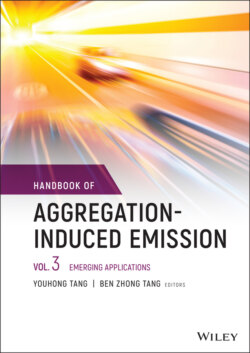Читать книгу Handbook of Aggregation-Induced Emission, Volume 3 - Группа авторов - Страница 33
2.6 Polymers
ОглавлениеCompared to the small molecule and supramolecular systems, polymers possess distinctive advantages, such as highly stable and readily processible. In 2013, Zhu et al. prepared the first conjugated polymer 69 with AICPL by incorporating difunctional TPE units and tyrosine‐derived pendants via Sonogashira reaction (Figure 2.24) [57]. The resulting polymer was nearly nonemissive in a THF solution, but appeared to be strongly luminescent upon the addition of water, indicating a typical AIE feature. It revealed obvious CPL around 500 nm both in solution and in the aggregated state, and the glum can be tuned from +0.08 to +0.44 by changing the content of water.
Figure 2.24 (a) Molecular structure of chiral TPE‐containing polymer 69 and corresponding glum. (b) Plot of (I/I0) values versus water fraction of polymer 69 in THF/H2O mixtures (1.0 × 10−5 M). (c) CPL dissymmetry factor glum versus water fraction of polymer 69 in THF/H2O mixtures (1.0 × 10−5 M).
Source: Reproduced with permission [57]. Copyright 2013, The Royal Society of Chemistry.
In 2015, Zhu and coworkers synthesized a series of chiral conjugated polymers (70–73) with AIE activity via Sonogashira and Suzuki reactions (Figure 2.25) [58]. R‐1,1′‐binaphthyl group and the TPE unit were introduced into the main chain as chiral moiety and AIE‐active moiety, respectively. The chiral conjugated polymers 70–73 all showed strong luminescence and obvious CD signals. However, only 70 exhibited detectable CPL signals around 530 nm in the aggregated state with glum of −1.6 × 10−3. Further morphology characterization showed that polymer 70 formed right‐handed helical nanostructure in the THF/H2O mixture, which was consistent with the negative CPL signal. In 2018, another two examples of chiral AIE‐active conjugated polymers 74 and 75 were prepared by Cheng et al. via click chemistry and Suzuki cross‐coupling reactions (Figure 2.25) [59, 60]. Polymer 74 exhibited weak luminescence and nearly no CPL signal in a THF solution. When fw of the THF/H2O mixture exceeded 40%, AICPL could be easily observed and glum reached up to −5.6 × 10−3 (around 500 nm) and +7.0 × 10−3 (around 500 nm) at fw = 90% for R‐74 and S‐74, respectively. Polymer 75 exhibited CPL with glum of −1.3 × 10−3 (496 nm) and +1.1 × 10−3 (496 nm) for R‐75 and S‐75, respectively, in the spin‐coated film. R‐75 and S‐75 were also used in doping‐free electroluminescent devices, which showed CPL centered at 505 nm with higher gEL of −1.9 × 10−2 and +2.4 × 10−2, respectively.
Figure 2.25 Molecular structures of AIE‐active chiral conjugated polymers 70–75 and corresponding glum [58–60].
In 2017, Cheng et al. reported five three‐component chiral conjugated polymers 76–80 incorporating the binaphthyl, fluorine, and TPE moieties, which functioned as the chiral source, Förster resonance energy transfer (FRET) donor and FRET acceptor, respectively (Figure 2.26) [61]. The polymers showed CPL with |glum| of 2.0–4.0 × 10−3 (480 nm). In the same year, Cheng et al. prepared two chiral conjugated polymers 81 and 82, which were comprised of four components as well as two FRET pairs (Figure 2.26) [62]. The fluorene moiety and the TPE unit formed the first FRET pair, and the later formed the second FRET pair with 4,7‐di(thiophen‐2‐yl)‐2,1,3‐benzothiadiazole moiety. Due to the existence of two FRET pairs, deep‐red luminescence with large Stokes shifts was observed. In addition, the glum reached up to ±2.0 × 10−3 (around 650 nm) in the aggregated state (fw = 99%).
Figure 2.26 Molecular structures of AIE‐active three‐component chiral conjugated polymers 76–80 and AIE‐active four‐component chiral conjugated polymers 81–82 and the corresponding glum [61, 62].
In 2018, Chen’s group synthesized a pair of conjugated polymers P‐83 and M‐83 with the TPE units and the chiral helical aromatic esters immobilized in the main chain (Figure 2.27) [63]. According to PL spectra, polymer 83 possessed a typical AIE feature with enhanced luminescence in the aggregated state. In THF solution, polymer 83 was CPL‐inactive. Upon mixing with water, AICPL centered at 500 nm was observed with glum of ±8.3 × 10−4.
Figure 2.27 (a) Molecular structures of AIE‐active chiral conjugated polymers P‐83 and M‐83 and corresponding glum. (b) PL, (c) CD spectra, and (d) CPL spectra of polymer 83 in various THF/H2O mixtures.
Source: Reproduced with permission [63]. Copyright 2018, The Royal Society of Chemistry.
In 2018, Tang’s group prepared an AIE‐active chiral polymer 84 by connecting alanine‐containing pendants and TPE units together via Cu(I)‐catalyzed click polymerization (Figure 2.28) [64]. In a dilute THF solution, the polymer exhibited weak CD and no apparent CPL signals. In the cast film, intense CPL around 500 nm was observed with glum of +4.5 × 10−3.
Figure 2.28 (a) Molecular structure of chiral conjugated polymer 84 and corresponding glum. (b) PL and CPL spectra of polymer 84 in a cast film.
Source: Reproduced with permission [64]. Copyright 2018, The Royal Society of Chemistry.
